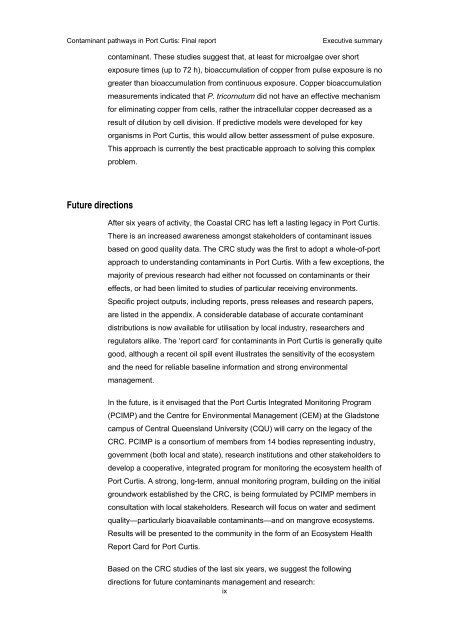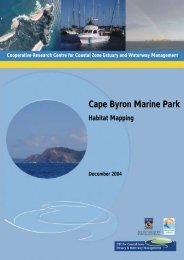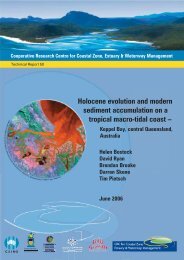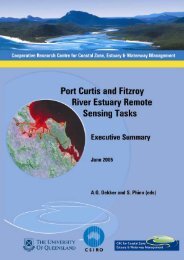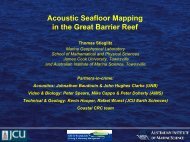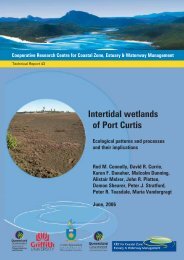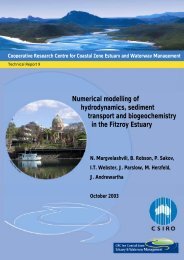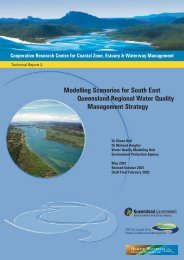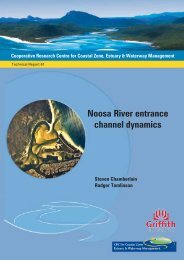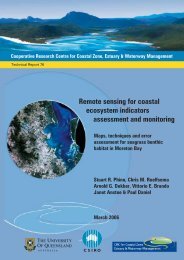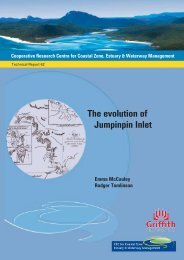Contaminant pathways in Port Curtis: Final report - OzCoasts
Contaminant pathways in Port Curtis: Final report - OzCoasts
Contaminant pathways in Port Curtis: Final report - OzCoasts
Create successful ePaper yourself
Turn your PDF publications into a flip-book with our unique Google optimized e-Paper software.
<strong>Contam<strong>in</strong>ant</strong> <strong>pathways</strong> <strong>in</strong> <strong>Port</strong> <strong>Curtis</strong>: F<strong>in</strong>al <strong>report</strong>Executive summarycontam<strong>in</strong>ant. These studies suggest that, at least for microalgae over shortexposure times (up to 72 h), bioaccumulation of copper from pulse exposure is nogreater than bioaccumulation from cont<strong>in</strong>uous exposure. Copper bioaccumulationmeasurements <strong>in</strong>dicated that P. tricornutum did not have an effective mechanismfor elim<strong>in</strong>at<strong>in</strong>g copper from cells, rather the <strong>in</strong>tracellular copper decreased as aresult of dilution by cell division. If predictive models were developed for keyorganisms <strong>in</strong> <strong>Port</strong> <strong>Curtis</strong>, this would allow better assessment of pulse exposure.This approach is currently the best practicable approach to solv<strong>in</strong>g this complexproblem.Future directionsAfter six years of activity, the Coastal CRC has left a last<strong>in</strong>g legacy <strong>in</strong> <strong>Port</strong> <strong>Curtis</strong>.There is an <strong>in</strong>creased awareness amongst stakeholders of contam<strong>in</strong>ant issuesbased on good quality data. The CRC study was the first to adopt a whole-of-portapproach to understand<strong>in</strong>g contam<strong>in</strong>ants <strong>in</strong> <strong>Port</strong> <strong>Curtis</strong>. With a few exceptions, themajority of previous research had either not focussed on contam<strong>in</strong>ants or theireffects, or had been limited to studies of particular receiv<strong>in</strong>g environments.Specific project outputs, <strong>in</strong>clud<strong>in</strong>g <strong>report</strong>s, press releases and research papers,are listed <strong>in</strong> the appendix. A considerable database of accurate contam<strong>in</strong>antdistributions is now available for utilisation by local <strong>in</strong>dustry, researchers andregulators alike. The ‘<strong>report</strong> card’ for contam<strong>in</strong>ants <strong>in</strong> <strong>Port</strong> <strong>Curtis</strong> is generally quitegood, although a recent oil spill event illustrates the sensitivity of the ecosystemand the need for reliable basel<strong>in</strong>e <strong>in</strong>formation and strong environmentalmanagement.In the future, is it envisaged that the <strong>Port</strong> <strong>Curtis</strong> Integrated Monitor<strong>in</strong>g Program(PCIMP) and the Centre for Environmental Management (CEM) at the Gladstonecampus of Central Queensland University (CQU) will carry on the legacy of theCRC. PCIMP is a consortium of members from 14 bodies represent<strong>in</strong>g <strong>in</strong>dustry,government (both local and state), research <strong>in</strong>stitutions and other stakeholders todevelop a cooperative, <strong>in</strong>tegrated program for monitor<strong>in</strong>g the ecosystem health of<strong>Port</strong> <strong>Curtis</strong>. A strong, long-term, annual monitor<strong>in</strong>g program, build<strong>in</strong>g on the <strong>in</strong>itialgroundwork established by the CRC, is be<strong>in</strong>g formulated by PCIMP members <strong>in</strong>consultation with local stakeholders. Research will focus on water and sedimentquality—particularly bioavailable contam<strong>in</strong>ants—and on mangrove ecosystems.Results will be presented to the community <strong>in</strong> the form of an Ecosystem HealthReport Card for <strong>Port</strong> <strong>Curtis</strong>.Based on the CRC studies of the last six years, we suggest the follow<strong>in</strong>gdirections for future contam<strong>in</strong>ants management and research:ix


